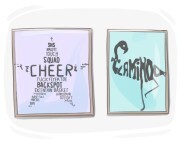Lingguwistika - Ortograpiya at Tipograpiya
Dito matututo ka ng ilang mga salitang Ingles na may kaugnayan sa ortograpiya at tipograpiya tulad ng "spelling", "cursive", at "italic".
Repasuhin
Flashcards
Pagbaybay
Pagsusulit

the act or the ability of putting letters in the correct order to form a word

pagbaybay, ispeling
the practice of using uppercase letters to signify the beginning of a sentence, proper nouns, and certain other grammatical elements for clarity and emphasis

paggamit ng malalaking titik, capitalisasyon
the use of marks such as a period, comma, etc. in writing to divide sentences and phrases to better convey meaning

bantas
a set of symbols or characters used to represent language in a visual or tangible form, allowing communication and the recording of information

sistema ng pagsulat, pamamaraan ng pagsulat
a writing system that represents the sounds of a language using consistent and predictable symbols or characters, allowing for a direct correspondence between written and spoken forms

ponemikong ortograpiya, sistema ng pagsulat na ponemiko
a style of handwriting in which the letters are joined together in a flowing manner, often written with continuous strokes and without lifting the pen or pencil from the paper

kurbadong sulat, magkadugtong na sulat
the art and technique of organizing written text in a visually appealing and readable manner

tipograpiya, sining ng pag-aayos ng teksto
a self-contained part of discourse that consists of one or more sentences dealing with a particular topic, indicated by indentation

talataan, parirala
the degree of consistency between the spelling and pronunciation of words in a writing system, with shallow orthographies having a high degree of consistency such as in Spanish and deep orthographies having a lower consistency such as in English

lalim ng ortograpiya, lalim ng pagbaybay
the small letters in a writing system, contrasting with uppercase, and commonly used in regular text

maliit na titik, lowercase
the set of capital or large letters in the Latin alphabet or other writing systems, typically used at the beginning of a sentence, for proper nouns, and for emphasis

malaking titik, malalaking titik
a linguistic or writing technique that uses pictures, symbols, or combinations of letters to represent words or sounds, often based on their phonetic similarity or association, creating visual puns or wordplay

prinsipyo ng rebus, pamamaraan ng rebus
a set of basic written symbols, representing the sounds of a language, which if put into correct orders form the words

alpabeto, abakada
a written character or symbol that represents an entire word or concept, rather than representing individual sounds or phonetic elements, as seen in some writing systems such as Chinese characters or Egyptian hieroglyphs

logogram, ideogram
the small decorative strokes or flourishes that extend from the ends of the main strokes of letters in a typeface, giving them a more traditional or formal appearance

serip, dekorasyon
a particular design or style of lettering, including the shape, size, and characteristics of the characters, that make up a complete set of fonts within a specific font family

uri ng titik, font
a different physical or visual representation of the same grapheme or character in a writing system

allograph, graphic variant
the smallest unit of a writing system that represents a distinct sound or phoneme in a language, such as a single letter, combination of letters, or symbol

grapema, pinakamaliit na yunit ng sistema ng pagsulat
a font style characterized by thick, heavy lines for emphasis or visibility
a cursive script with slanted letters that are connected and flowing in appearance

pahilis, sulat na pahilis
a typeface or font that does not have small decorative strokes or serifs at the ends of the main letterforms, giving it a clean and modern appearance

walang serip
the typographic variation of the digit "0" in which a diagonal slash is added across the zero to distinguish it from the letter "O" and indicate that it represents the numerical zero

slashed zero, zero na may slash
a typographic term that refers to the combination of two or more letters or characters into a single interconnected glyph, often used to enhance readability or aesthetic appeal in certain typefaces or scripts

ligatura, pinagsamang glyph
(linguistics) a mark that is written below or above a letter indicating a difference in pronunciation

diakritiko, markang diakritiko
a diacritic used in various languages and writing systems to indicate different linguistic features such as stress, pitch, or vowel quality

acute accent
the symbol ~ put over the letter n in Spanish, or a and o in Portuguese to indicate nasalization

tilde, tuldik
the mark that appears as a small hook put under the letter 'c' indicating that it has a /s/ sound, rather than a /k/ sound

sedilya, maliit na markang hugis kawit na inilalagay sa ilalim ng letrang 'c'
the mark ^, placed over a vowel in some languages indicating contraction, length, etc.

circumflex, markang circumflex
the diacritic mark ` placed above a vowel in some languages indicating an altered pronunciation in case of quality, quantity or pitch

grave, tuldik na grave
the mark ¨, put over a vowel indicating an articulation with rounding or fronting

umlaut, dalawang tuldok
a graphic symbol that signifies a word, phrase, physical object, etc.

piktograpo, grafikong simbolo
a symbol or graphic representation that directly represents a concept or idea, often without relying on specific sounds or language, commonly used in pictographic or logographic writing systems

ideograma, grapikong simbolo
a letter in a word that is not pronounced when the word is spoken, although it may still affect the pronunciation or meaning of the word

tahimik na titik, di binibigkas na titik
a letter used in some languages, such as Old English and Icelandic, to represent the voiced "th" sound, and is derived from the runic letter "d"

isang titik na ginagamit sa ilang wika, tulad ng Lumang Ingles at Icelandic
a diacritic mark used in some writing systems, such as Devanagari and Indic scripts, to indicate the absence of a vowel sound following a consonant, effectively suppressing the inherent vowel

virama, isang diakritikong marka na ginagamit sa ilang sistema ng pagsulat
the art of producing beautiful handwriting using special writing instruments such as a dip or brush pen

kaligrapiya, sining ng magandang pagsulat
a style of Chinese calligraphy that emerged during the Han Dynasty and was commonly used for official documents and bureaucratic purposes, characterized by its simplified and standardized form with square-shaped characters and clear strokes

sulat ng klero, estilong klerikal
an ancient style of writing used in China during the late Zhou Dynasty and the Qin Dynasty, characterized by its pictographic and abstract forms, with characters often featuring intricate and flowing lines

sulat ng selyo, script ng selyo
a standardized style of Chinese calligraphy characterized by its balanced and uniform strokes, widely used for its readability and simplicity

regular na sulat, pamantayang istilo
a semi-cursive style of Chinese calligraphy that exhibits a fluid and connected writing with simplified strokes, striking a balance between the cursive and regular scripts

semi-cursive style ng Chinese calligraphy, bahagyang nakakabit na sulat Tsino
the logographic characters adopted from Chinese characters and used in the Japanese writing system

kanji, mga karakter na kanji
a fundamental component of the Japanese writing system, comprising 46 characters that represent syllables and are utilized for native Japanese words, grammatical purposes, and verb endings

hiragana, isang pangunahing bahagi ng sistema ng pagsulat ng Hapon
a component in the Japanese writing system, consisting of 46 characters that represent syllables and are primarily used for borrowed words, foreign names, onomatopoeia, and emphasis

katakana, isang sangkap sa sistema ng pagsulat ng Hapon
the Chinese characters that are used in the Korean writing system, representing both meaning and sound and used in conjunction with the Korean alphabet, Hangul, to write words of Chinese origin or to clarify the meaning of Korean words

ang mga karakter ng Intsik na ginagamit sa sistema ng pagsulat ng Koreano, na kumakatawan sa parehong kahulugan at tunog at ginagamit kasabay ng alpabetong Koreano
a letter or character from the runic alphabet, used in various Germanic languages during the early Middle Ages

rune, karakter ng runic
a single mark, line, or brush movement used to form characters in writing systems such as Chinese, Japanese, or Korean



